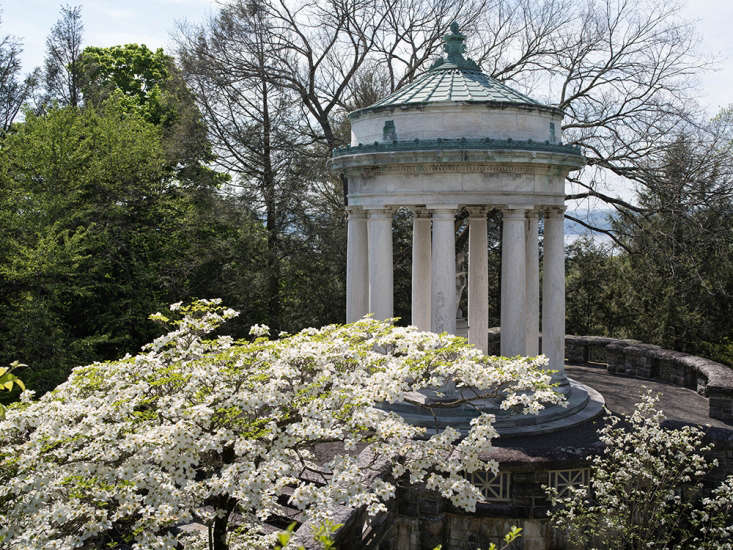Now that spring is here, many city dwellers are longing for greenery and making plans to escape to the country. For a brief break from urban life, we New Yorkers often look to the north where old homes overlooking the Hudson River offer gracious gardens and a taste of the past. Kykuit, the country retreat of oil baron John D. Rockefeller, is located near Tarrytown, about 30 miles north of New York City and the perfect distance for a day trip. For an advance taste of what Kykuit has to offer, you might pick up a copy of The Rockefeller Family Gardens: An American Legacy, published today by Monacelli Press.
Photographs by Larry Lederman.

The new book features the photographs of Larry Lederman, a man apparently undeterred by inhospitable weather conditions, who seems to have discovered every tiny nook and cranny of the place. He shows us Rockefeller’s creation over a period of years in all seasons and in all kinds of light. We see it early in the morning and at dusk, under gray skies and gleaming in the sun, bursting into bloom in spring, blazing with hot fall color and serenely quiet after a snow fall.

For the prospective visitor, The Rockefeller Family Gardens offers an extensive preview of the 250-acre grounds that surround the classic six-story stone house. Text by Cynthia Bronson Altman, curator of the collections at Kykuit, provides historical context enhanced by archival photos. From her we learn about the estate’s creation at the turn of the 2oth century, its initial layout by the Olmsted Brothers, the passionate involvement of John D. Rockefeller, and the subsequent changes made by its later caretakers, John D. Rockefeller, Jr. and Nelson Rockefeller.

Bosworth’s ornate antiquity-inspired grottos, columns, fountains, and grand staircases have had to share garden space with some unlikely neighbors: the modern sculptures in Nelson Rockefeller’s extensive collection of 20th century art. Lederman gives ample attention to both the classical and the modern statues at Kykuit, often framing scenes that show antique and contemporary works in close proximity.

Kykuit was home to four generations of Rockefellers and is now owned by the National Trust for Historic Preservation. It is the site of the Pocantico Center, a venue for conferences and meetings which is operated by the Rockefeller Brothers Fund, a family foundation helping to advance social change. The public is allowed onto the property from May through September through guided tours offered by the Historic Hudson Valley, a non-profit educational organization.

Much of this book presents parts of Kykuit that can be seen on public tours, but Lederman includes a couple of hidden surprises. There is a chapter on the Japanese Garden at Kykuit which is not open to public view. Created in 1908 by John D. Rockefeller Jr. and his wife Abby Aldrich Rockefeller, who were leading collectors of Asian art, it includes several types of traditional types of Japanese garden: the stroll garden, the hill and pond, the tea garden, and the kare-sansui or dry landscape. Lederman’s camera records many details of this lovely place. We see cherry blossoms and azaleas in bloom in spring, the many shades of green in summer, and the Japanese maples in their fall glory.

The final chapter of this book is about another Japanese garden created by the Rockefellers ,and it is a major revelation. After creating the Japanese garden at Kykuit, John D. Rockefeller Jr. and his wife went on to create a second one in Maine for The Eyrie, their summer home in Seal Harbor on Mount Desert Island. Unlike the project at Kykuit, which contained many classic elements of Japanese garden design, the Abby Aldrich Rockefeller Garden is a mixture of eastern and western influences. It is the work of famed designer Beatrix Farrand, who had never designed a Japanese garden, and so included a vast cutting garden and other distinctly non-traditional features.

The Abby Aldrich Rockefeller Garden in Seal Harbor, Maine is a private garden, but it is open to visitors by reservation one day a week from mid-July until early September. In 2017 the opening day is Thursday, July 13 and visitors will be able to tour the garden every subsequent Thursday through September 7.










Have a Question or Comment About This Post?
Join the conversation